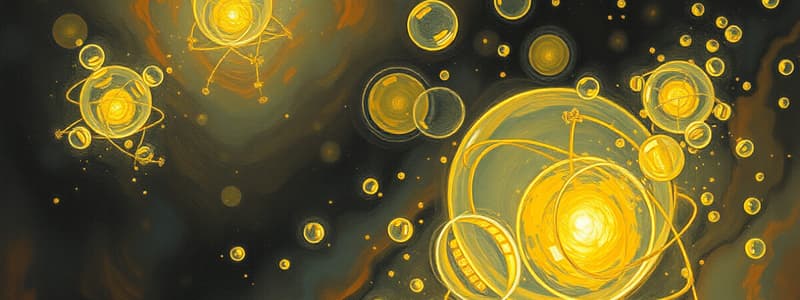Podcast
Questions and Answers
What is atomic mass?
What is atomic mass?
- The sum of the atomic weights of atoms in a molecule
- The smallest whole number ratio of the atoms in a compound
- The SI unit used to measure amount of substance
- The number of grams of an element that is naturally equal to the atomic mass of the element in amu (correct)
What is formula mass?
What is formula mass?
The sum of the atomic weights of atoms in a molecule
What is a mole?
What is a mole?
The SI unit used to measure amount of substance
What is an empirical formula?
What is an empirical formula?
What does STP stand for?
What does STP stand for?
What is molar mass?
What is molar mass?
What is molar volume?
What is molar volume?
What is Avogadro's number?
What is Avogadro's number?
What is molecular mass?
What is molecular mass?
What is percent composition?
What is percent composition?
What are the representative particles?
What are the representative particles?
What are the diatomic elements?
What are the diatomic elements?
What is the value of Avogadro's number?
What is the value of Avogadro's number?
What is the relationship of Avogadro's number?
What is the relationship of Avogadro's number?
What is the molar volume of a gas at STP?
What is the molar volume of a gas at STP?
What is the value of ST?
What is the value of ST?
What is the value of SP?
What is the value of SP?
Can the empirical formula of C6H12O6 be simplified?
Can the empirical formula of C6H12O6 be simplified?
What are three ways quantities can be measured?
What are three ways quantities can be measured?
Determine moles of an atom: Atom's subscript x number of moles of molecule (0.2 mol H2O = 0.4 x 0.2 = _____ mol)
Determine moles of an atom: Atom's subscript x number of moles of molecule (0.2 mol H2O = 0.4 x 0.2 = _____ mol)
Determine the total number of atoms: Number of atoms in formula x mol of substance x Avogadro's number (0.7 mol C6H6 = 0.7(12)(6.02 x 10^23)) = _____
Determine the total number of atoms: Number of atoms in formula x mol of substance x Avogadro's number (0.7 mol C6H6 = 0.7(12)(6.02 x 10^23)) = _____
How do you calculate gmm?
How do you calculate gmm?
What is molar mass conversion?
What is molar mass conversion?
What is the density of gases at STP?
What is the density of gases at STP?
How to find mole of gas from volume at STP?
How to find mole of gas from volume at STP?
How to find gas volumes from moles at STP?
How to find gas volumes from moles at STP?
What is the formula for percent composition?
What is the formula for percent composition?
What is the molecular formula relationship?
What is the molecular formula relationship?
Flashcards are hidden until you start studying
Study Notes
Atomic Concepts
- Atomic mass: Measured in grams, equivalent to the element's atomic mass in amu.
- Mole: SI unit for amount of substance, crucial in determining quantities in chemical reactions.
- Molar mass: Mass of one mole of an element or compound, vital for stoichiometric calculations.
- Molecular mass: Total of atomic masses in a molecule, essential for understanding molecular weight.
Formulas and Ratios
- Empirical formula: Represents the simplest whole-number ratio of elements in a compound, showing relative proportions.
- Molecular formula: Shows the actual number of atoms of each element in a molecule, derived from empirical formula multiplied by a whole number.
- Percent composition: Calculation of the percentage by mass of each element in the compound, key for determining formula stoichiometry.
Gas Laws and Concepts
- STP (Standard Temperature and Pressure): Defined as 0 degrees Celsius (273 K) and 1 atm (101.3 kPa), important for gas calculations.
- Molar volume of gas at STP: Occupies 22.4 L, essential for converting between volume and moles of gas.
- Density of gases at STP: Density calculated as grams of substance per 22.4 L, useful for gas property assessments.
Key Constants
- Avogadro's number: 6.02 x 10^23, the number of representative particles in one mole, fundamental in molecular counting.
Measurement Techniques
- Representative particles: May include atoms (e.g., Al), molecules (e.g., H₂O), or ions (e.g., NO₃⁻), depending on the substance.
- Three ways to measure quantities: Mass, volume, and count, crucial for quantifying substances in chemistry.
Calculation Methods
- Molar mass conversion: Calculate the number of moles by dividing grams by molar mass or vice versa, vital for stoichiometric problem-solving.
- Determining total number of atoms: Multiply the number of atoms in a formula by the number of moles and Avogadro's number.
- Calculating grams per mole (gmm): Summation of atomic masses to find the molecular weight of compounds.
Special Cases
- Diatomic elements: Hydrogen, Nitrogen, Oxygen, Bromine, Fluorine, Chlorine, and Iodine exist naturally as molecules composed of two atoms.
- Empirical vs. molecular formula determination: Example provided: C₆H₁₂O₆ can be simplified to C₁H₂O, showcasing the difference between empirical and molecular representations.
Practical Applications
- Conversion between moles and gas volumes at STP: Calculate moles using volume divided by 22.4 L or vice versa to understand gas behavior in reactions.
- Percent composition formula: Key for analyzing the makeup of compounds (mass of element in compound divided by the formula weight of compound, multiplied by 100).
Studying That Suits You
Use AI to generate personalized quizzes and flashcards to suit your learning preferences.




